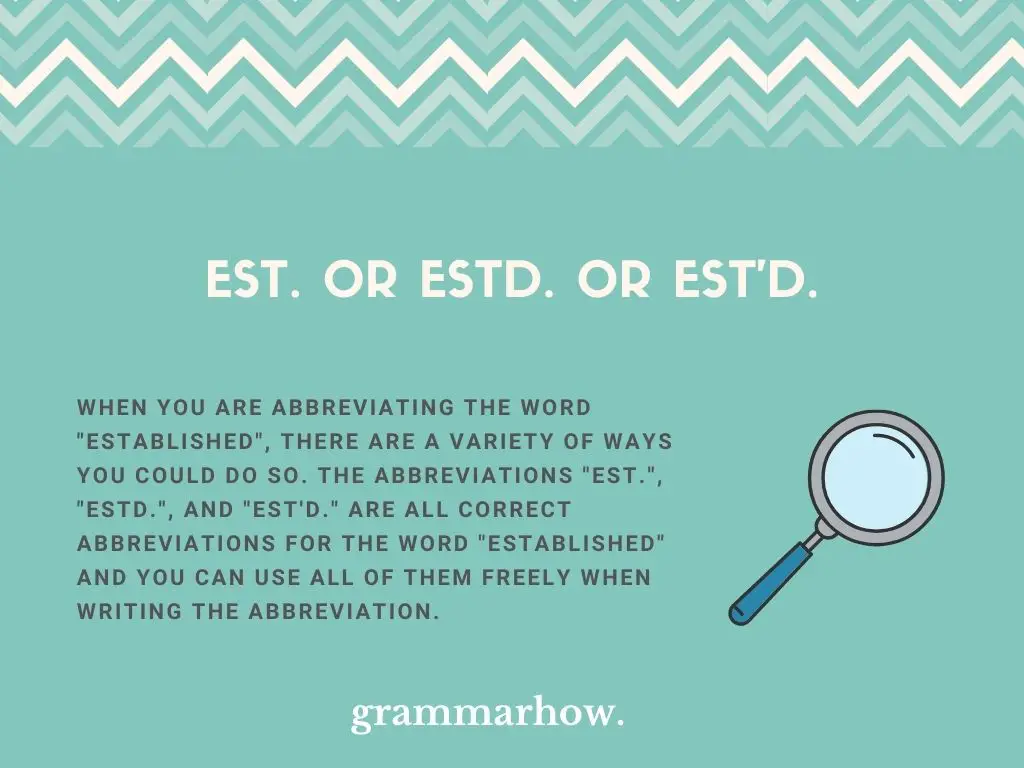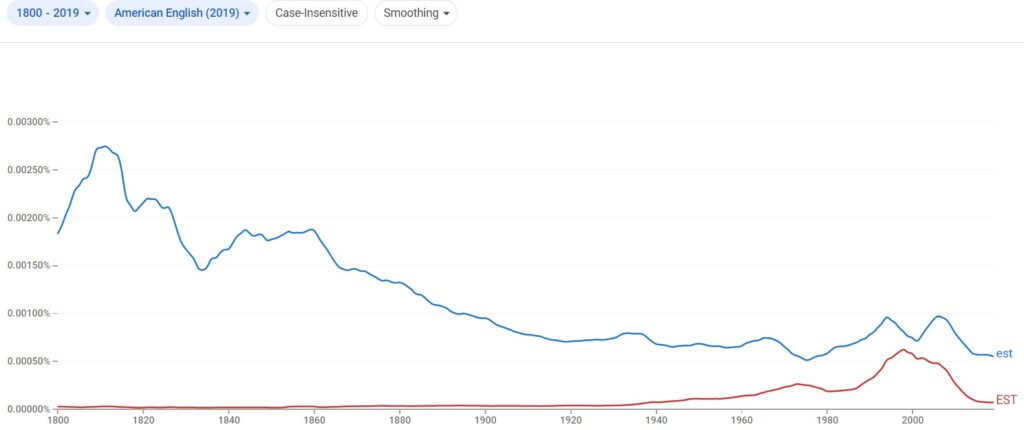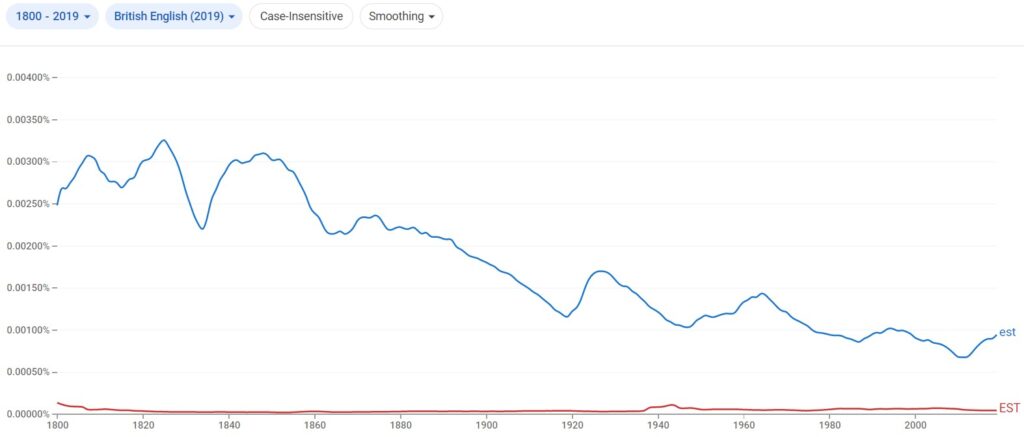You may notice plaques or dedications all over the area where you live, stating what year something was founded. On these plaques, you may notice several variations of the same abbreviation on different dedications. These abbreviations all refer to the word “established”, but why are there so many variations, and what is the difference between them?
Est. or Estd. or Est’d. – What Is The Abbreviation For “Established”?
When you are abbreviating the word “established”, there are a variety of ways you could do so. The abbreviations “Est.”, “Estd.”, and “Est’d.” are all correct abbreviations for the word “established” and you can use all of them freely when writing the abbreviation.

If you are looking to shorten or abbreviate the word “established”, the most commonly used abbreviation of the word is “Est”. You will see this abbreviation on many buildings, plaques, and signs announcing when something was founded.
While both “Estd.” and ‘Est’d.” are abbreviations that are still acceptable to use, they are used much less often. However, this does not mean you should refrain from using them for any reason.
What Does The Abbreviation For “Established” Mean?
The abbreviation for “established” means it is the shortened version of the word “established” in reference to a time or date when something was founded. When you see the abbreviations for “established”, you will most likely see a few different ones.
Despite there being multiple abbreviations for the word “established”, all of them are used the same way to refer to when something was founded. You may commonly see “Est,”, “Estd.”, and “Est’d.” in various places so be sure to remember that they are all abbreviations for the word “established”.
Should I Use A Punctuation Mark After “Est.”, “Estd.”, and “Est’d”?
When using the abbreviation for “established”, use a punctuation mark immediately after the abbreviation, making the abbreviations “Est.”, ‘Estd”, and “Est’d.”. In American English, all abbreviations require a punctuation mark after them, with the exception of if they are ending the sentence and already have a punctuation mark.
American English uses punctuation marks after all abbreviations, such as “Dr.”, “Mr.”, and “Ave.”. This shows that it is an abbreviation, which requires a full stop at the end to signify the end of the word regarding the usage of an abbreviation. Therefore, if you are abbreviating a word, you must put a punctuation mark where you are stopping the word.
Is “Est.”, “Estd.”, or “Est’d”. Used The Most?
According to the Google Ngram Viewer, a helpful tool for comparing words and phrases over time, “Est.” is the most commonly used abbreviation for “established”. “Est.” had its most recent peak in usage roughly 200 years ago in the mid-1820s, but has still continued to be the popular choice.

Both of the other two commonly used abbreviations for “established”, “Estd.” and “Est’d.”, are very rarely used in comparison to the abbreviation “Est”. Because these two abbreviations are not commonly used, it is very difficult to determine any peak in their usage, as it has been quite consistent in their amount of usage for more than five hundred years.
Is It Ever Correct To Use “EST.” As The Abbreviation For Established?
There are many correct ways to abbreviate the word “established” and using “EST.” is one of them. The abbreviations for “established” can be completely lowercase, all uppercase, or can have the first letter in the abbreviation capitalized.
According to the Google Ngram Viewer, a helpful tool for comparing words and phrases over time, the US prefers to use “est.”, the lowercase-only version of the abbreviation. However, “EST.” the capitalized version of the abbreviation follows the same trend in usage as the lowercase version, rising and falling in popularity in the same pattern as “est.”

According to the Google Ngram Viewer, the UK also prefers to use “est.”, the lowercase-only version of the abbreviation as well. In the UK, the abbreviation “EST.” is used very infrequently, holding roughly the same amount of usage each year for more than two hundred years in a row.

Examples Of How To Use The Abbreviation For “Established” In A Sentence
When it comes to using abbreviations for the word “established” in a sentence, there are very few rules. One rule to follow is knowing that the abbreviation is not used unless it is necessary, has the word “established” used very frequently already, or is needed in order to save necessary space.
The other rule to make sure to follow is to place a punctuation mark after the abbreviation unless it is ending the sentence, as you cannot end a sentence with two periods next to one another.
Here are several example sentences for you to reference if you are in need of them.
- The small plaque read, “Est. 1982”.
- She made a note of the sign that said, “Yarrow Park Estd. 1892”.
- The teacher commended him for using “Est’d. 1747”, showing his knowledge of the correct abbreviation and year on his test.
- After having been est. in 1794, the school was finally receiving an award to celebrate the teaching of exceptional education for more than two-hundred years.
- The town has been relatively peaceful ever since the community est. an agreed-up set of laws several decades ago.
- With the passing of his father, he inherited the est’d. duties he was expected to maintain which came with inheriting a historical building.
- Since the concept of a free economy was estd., the largest monopoly corporation crumbled as citizens boycotted all of their products and stores.
- If you don’t follow the est. way of living in a town, you may be considered strange and become ostracized by the residents.
- She helped to est. the technology required today that is used as the core operating system for phones, internet, and wifi to function.
- A statue was dedicated to the woman who introduced sanitary medical practices within the area and the plaque on it read “EST. 1899”.
- Est’d. in 2001, the practice of taking off your shoes when going through airport security has become a core part of helping to keep flying safe.

Martin holds a Master’s degree in Finance and International Business. He has six years of experience in professional communication with clients, executives, and colleagues. Furthermore, he has teaching experience from Aarhus University. Martin has been featured as an expert in communication and teaching on Forbes and Shopify. Read more about Martin here.
